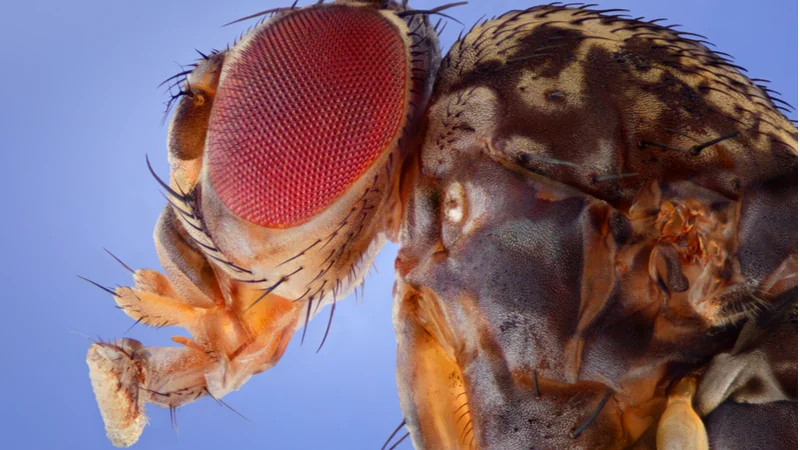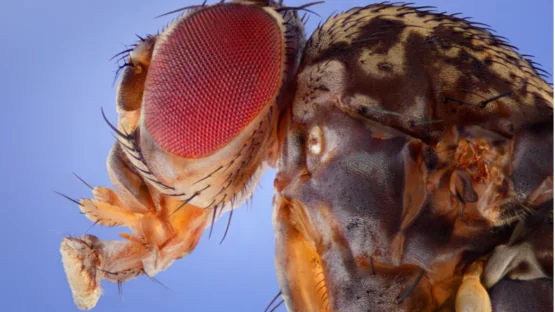Increasing an important protein regulator improves the lifespan of Drosophila flies, according to a new paper published in Aging.
Found in both animals and plants
As the researchers explain, phosphatidylethanolamine-binding proteins (PEBPs) are present in both plant and animal cells. These proteins are critical to multiple fundamental cellular functions, including in cancer cells [1,2]. While suppressing these proteins has been proposed as a method to fight cancer, PEBP dysregulation is associated with Alzheimer’s [3] and kidney disease [4].
Ironically, the researchers chose two proteins found specifically in tobacco, a plant not known for having a positive relationship with human health. These proteins are NtFT4, which promotes flower activation, and NtFT2, which represses it; the difference between these two is a single amino acid [5].
A one-way relationship
The researchers first attempted to compare the two by introducing animal PEBPs into the genetics of plants, along with overexpression of NtFT4 for comparison. While NtFT4, as expected, had a significant impact on flowering time, animal PEBPs had no effect, even when a canonical means of interaction had been previously documented.
The researchers then examined the effects of PEBPs on Drosophila flies. In addition to a control group of unmodified flies, they created four separate lines: a group that overexpressed CG7054, which is a PEBP normally found in these flies; a group that had CG7054 silenced through RNA; a group that expressed NtFT2; and a group that expressed NtFT4.
As expected, the CG7054-deficient group died very quickly in both sexes; many of them did not even survive the pupal stages. Female overexpressors of CG7054 lived notably longer than their control counterparts, while the effect was less pronounced in males.
NtFT2 had an interesting relationship with lifespan. Drosophila flies, especially females, tend to live for a generally fixed amount of time, 47 days, and then quickly start dying. Introducing NtFT2 caused some of the flies to die sooner than their unmodified counterparts, but it also caused some of the flies to live longer, in both males and females.
NtFT4 had the most pronounced effect, especially in females. There was an immediate drop-off in the curve, but it simply occurred later; after day 50, almost all of the female flies in the control group were dead, but almost all of the female flies in this modified group were still alive. Interestingly, while it did not affect locomotor performance in females, it greatly increased locomotor activity in males.
A detailed investigation
Following these results, the researchers further investigated the role of NtFT4 in the expression of other proteins. They found that NtFT4 interacts with, and increase the levels of, the heat shock proteins Hsp26 and Hsp27, which are associated with longevity and decline with age in these flies. The researchers dug deeper and found that NtFT4 has effects on protein-modifying enzymes, enzymes that work on metabolism, and many genes whose functions are completely unknown.
Conclusion
Along with previous research, this research demonstrates the importance of fundamental proteostasis regulators in aging. Given the previously documented dangers in increasing and decreasing PEBPs, these proteins by themselves do not seem to be a suitable target for simple interventions; instead, it is the maintenance of PEBP levels that seems to be critical in fighting against proteostasis-based and other age-related disorders.
Therefore, future research should examine how and why these proteins become decreased or dysregulated with age. It may be possible to intervene in order to maintain cellular homeostasis; in other words, giving our cells the ability to safely maintain the levels of the proteins we need to stay in good health.
Literature
[1] Zeng, L., Imamoto, A., & Rosner, M. R. (2008). Raf kinase inhibitory protein (RKIP): a physiological regulator and future therapeutic target. Expert opinion on therapeutic targets, 12(10), 1275-1287.
[2] Jian, W., Bai, Y., Li, X., Kang, J., Lei, Y., & Xue, Y. (2019). Phosphatidylethanolamine-binding protein 4 promotes the epithelial-to-mesenchymal transition in non–small cell lung cancer cells by activating the sonic hedgehog signaling pathway. Journal of Cellular Biochemistry, 120(4), 5386-5395.
[3] George, A. J., Holsinger, R. D., McLean, C. A., Tan, S. S., Scott, H. S., Cardamone, T., … & Li, Q. X. (2006). Decreased phosphatidylethanolamine binding protein expression correlates with Aß accumulation in the Tg2576 mouse model of Alzheimer’s disease. Neurobiology of aging, 27(4), 614-623.
[4] Taylor, S., Pieri, K., Nanni, P., Tica, J., Barratt, J., & Didangelos, A. (2019). Phosphatidylethanolamine binding protein-4 (PEBP4) is increased in IgA nephropathy and is associated with IgA-positive B-cells in affected kidneys. Journal of autoimmunity, 105, 102309.
[5] Ho, W. W. H., & Weigel, D. (2014). Structural features determining flower-promoting activity of Arabidopsis FLOWERING LOCUS T. The Plant Cell, 26(2), 552-564.




